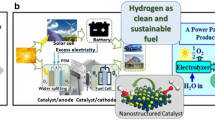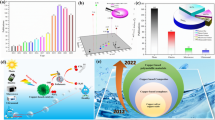Abstract
Acidic solutions of trans-cinnamic acid at pH 3.0 have been comparatively treated by anodic oxidation with electrogenerated H2O2 (AO-H2O2), electro-Fenton (EF), and photoelectro-Fenton (PEF). The electrolytic experiments were carried out with a boron-doped diamond (BDD)/air-diffusion cell. The substrate was very slowly abated by AO-H2O2 because of its low reaction rate with oxidizing •OH produced from water discharge at the BDD anode. In contrast, its removal was very rapid and at similar rate by EF and PEF due to the additional oxidation by •OH in the bulk, formed from Fenton’s reaction between cathodically generated H2O2 and added Fe2+. The AO-H2O2 treatment yielded the lowest mineralization. The EF process led to persistent final products like Fe(III) complexes, which were quickly photolyzed upon UVA irradiation in PEF to give an almost total mineralization with 98 % total organic carbon removal. The effect of current density and substrate concentration on all the mineralization processes was examined. Gas chromatography–mass spectrometry (GC-MS) analysis of electrolyzed solutions allowed identifying five primary aromatics and one heteroaromatic molecule, whereas final carboxylic acids like fumaric, acetic, and oxalic were quantified by ion exclusion high-performance liquid chromatography (HPLC). From all the products detected, a degradation route for trans-cinnamic acid is proposed.








Similar content being viewed by others
References
Assumpção MHMT, Moraes A, De Souza RFB, Reis RM, Rocha RS, Gaubeur I, Calegaro ML, Hammer P, Lanza MRV, Santos MC (2013) Degradation of dipyrone via advanced oxidation processes using a cerium nanostructured electrocatalyst material. Appl Catal A Gen 462–463:256–261
Borràs N, Oliver R, Arias C, Brillas E (2010) Degradation of atrazine by electrochemical advanced oxidation processes using a boron-doped diamond anode. J Phys Chem A 114(24):6613–6621
Boye B, Dieng MM, Brillas E (2003) Electrochemical degradation of 2,4,5-trichlorophenoxyacetic acid in aqueous medium by peroxi-coagulation. Effect of pH and UV light. Electrochim Acta 48(7):781–790
Brillas E, Martínez-Huitle CA (2015) Decontamination of wastewaters containing synthetic organic dyes by electrochemical methods. An updated review. Appl Catal B Environ 166–167:603–643
Cavalcanti EB, Garcia-Segura S, Centellas F, Brillas E (2013) Electrochemical incineration of omeprazole in neutral aqueous medium using a platinum or boron-doped diamond. Degradation kinetics and oxidation products. Water Res 47(5):1803–1815
Chatzisymeon E, Dimou A, Mantzavinos D, Katsaounis A (2009) Electrochemical oxidation of model compounds and olive mill wastewater over DSA electrodes: 1. The case of Ti/IrO2 anode. J Hazard Mater 167(1-3):268–274
Ciríaco L, Anjo C, Correia J, Pacheco MJ, Lopes A (2009) Electrochemical degradation of ibuprofen on Ti/Pt/PbO2 and Si/BDD electrodes. Electrochim Acta 54(5):1464–1472
Cruz-González K, Torres-López O, García-León A, Guzmán-Mar JL, Reyes LH, Hernández-Ramírez A, Peralta-Hernández JM (2010) Determination of optimum operating parameters for Acid Yellow 36 decolorization by electro-Fenton process using BDD cathode. Chem Eng J 160(1):199–206
Cruz-González K, Torres-López O, García-León A, Brillas E, Hernández-Ramírez A, Peralta-Hernández JM (2012) Optimization of electro-Fenton/BDD process for decolorization of a model azo dye wastewater by means of response surface methodology. Desalination 286:63–68
Deeb AA, Fayyad MK, Alawi MA (2012) Separation of polyphenols from Jordanian olive oil mill wastewater. Cromatogr Res Int Article ID 812127, 8 pp
Di Gioia D, Bertin L, Fava F, Marchetti L (2001) Biodegradation of hydroxylated and methoxylated benzoic, phenylacetic and phenylpropenoic acids present in olive mill wastewaters by two bacterial strains. Res Microbiol 152(1):83–93
Dirany A, Sirés I, Oturan N, Özcan A, Oturan MA (2012) Electrochemical treatment of the antibiotic sulfachloropyridazine: kinetics, reaction pathways, and toxicity evolution. Environ Sci Technol 46(7):4074–4082
El-Ghenymy A, Rodríguez RM, Brillas E, Oturan N, Oturan MA (2014) Electro-Fenton degradation of the antibiotic sulfanilamide with Pt/carbon-felt and BDD/carbon-felt cells. Kinetics, reaction intermediates, and toxicity assessment. Environ Sci Pollut Res 21(14):8368–8378
Florenza X, Solano AMS, Centellas F, Martínez-Huitle CA, Brillas E, Garcia-Segura S (2014) Degradation of the azo dye Acid Red 1 by anodic oxidation and indirect electrochemical processes based on Fenton’s reaction chemistry. Relationship between decolorization, mineralization and products. Electrochim Acta 142:276–288
Guinea E, Brillas E, Centellas F, Cañizares P, Rodrigo MA, Saez C (2009) Oxidation of enrofloxacin with conductive-diamond electrochemical oxidation, ozonation and Fenton oxidation. A comparison. Water Res 43(8):2131–2138
Hakkim FL, Miura M, Matsuda N, Alharassi AS, Guillemin G, Yamauchi M, Arivazhagan G, Song H (2014) An in vitro evidence for caffeic acid, rosmarinic acid and trans-cinnamic acid as a skin protectant against γ-radiation. Int J Low Rad 9(4):305–316
Hojati M, Modarres-Sanavy SAM, Enferadi ST, Majdi M, Ghanati F, Farzadfar S (2015) Differential deployment of parthenolide and phenylpropanoids in feverfew plants subjected to divalent heavy metals and trans-cinnamic acid. Plant Soil. doi:10.1007/s11104-015-2677-0
Khataee A, Khataee A, Fathinia M, Vahid B, Joo SW (2013) Kinetic modeling of photoassisted-electrochemical process for degradation of an azo dye using boron-doped diamond anode and cathode with carbon nanotubes. J Ind Eng Chem 19(6):1890–1894
Khataee A, Akbarpour A, Vahi B (2014) Photoassisted electrochemical degradation of an azo dye using Ti/RuO2 anode and carbon nanotubes containing gas-diffusion cathode. J Taiwan Inst Chem Eng 45(3):930–936
Kontos SS, Koutsoukos PG, Paraskeva CA (2014) Removal and recovery of phenolic compounds from olive mill wastewater by cooling crystallization. Chem Eng J 251:319–328
Lafont F, Garcia IM, Aramendia MA, Marinas JM, Urbano FJ, Fernandez JM, Marti V (2001) Automated on-line solid-phase extraction and HPLC-mass spectrometry for rapid determination of phenolic compounds found in olive mill wastewaters. Adv Mass Spectrom 15:875–876
Letizia CS, Cocchiara J, Lapczynski A, Lalko J, Api AM (2005) Fragrance material review on cinnamic acid. Food Chem Toxicol 43(6):925–943
Lopes RJG, Quinta-Ferreira RM (2010) Assessment of CFD-VOF method for trickle-bed reactor modeling in the catalytic wet oxidation of phenolic wastewater. Ind Eng Chem Res 49(6):2638–2648
Lopes RJG, Silva AMT, Quinta-Ferreira RM (2007) Screening of catalysts and effect of temperature for kinetic degradation studies of aromatic compounds during wet oxidation. Appl Catal B Environ 73(1-2):193–202
Marselli B, Garcia-Gomez J, Michaud PA, Rodrigo MA, Comninellis C (2003) Electrogeneration of hydroxyl radicals on boron-doped diamond electrodes. J Electrochem Soc 150(3):D79–D83
Martínez-Huitle CA, Ferro S (2006) Electrochemical oxidation of organic pollutants for the wastewater treatment: direct and indirect processes. Chem Soc Rev 35(12):1324–1340
Moreira FC, Garcia-Segura S, Vilar VJP, Boaventura RAR, Brillas E (2013) Decolorization and mineralization of Sunset Yellow FCF azo dye by anodic oxidation, electro-Fenton, UVA photoelectro-Fenton and solar photoelectro-Fenton processes. Appl Catal B Environ 142–143:877–890
Panizza M, Cerisola G (2009) Direct and mediated anodic oxidation of organic pollutants. Chem Rev 109(12):6541–6569
Rodrigo MA, Cañizares P, Sánchez-Carretero A, Sáez C (2010) Use of conductive-diamond electrochemical oxidation for wastewater treatment. Catal Today 151(1-2):173–177
Ruiz EJ, Hernández-Ramírez A, Peralta-Hernández JM, Arias C, Brillas E (2011) Application of solar photoelectro-Fenton technology to azo dyes mineralization: effect of current density, Fe2+ and dye concentrations. Chem Eng J 171(2):385–392
Sanchez I, Stüber F, Fabregat A, Font J, Fortuny A, Bengoa C (2012) Degradation of model olive mill contaminants of OMW catalysed by zero-valent iron enhanced with a chelant. J Hazard Mater 199–200:328–335
Sirés I, Brillas E (2012) Remediation of water pollution caused by pharmaceutical residues based on electrochemical separation and degradation technologies: a review. Environ Int 40:212–229
Sirés I, Brillas E, Oturan MA, Rodrigo MA, Panizza M (2014) Electrochemical advanced oxidation processes: today and tomorrow. A review. Environ Sci Pollut Res 21(14):8336–8367
Thiam A, Zhou M, Brillas E, Sirés I (2014) Two-step mineralization of Tartrazine solutions: study of parameters and by-products during the coupling of electrocoagulation with electrochemical advanced oxidation processes. Appl Catal B Environ 150–151:116–125
Thiam A, Sirés I, Centellas F, Cabot PL, Brillas E (2015a) Decolorization and mineralization of Allura Red AC azo dye by solar photoelectro-Fenton: identification of intermediates. Chemosphere 136:1–8
Thiam A, Sirés I, Garrido JA, Rodríguez RM, Brillas E (2015b) Decolorization and mineralization of Allura Red AC aqueous solutions by electrochemical advanced oxidation processes. J Hazard Mater 290:34–42
Vasudevan S, Oturan MA (2014) Electrochemistry: as cause and cure in water pollution-an overview. Environ Chem Lett 12(1):97–108
Vatanpour V, Daneshvar N, Rasoulifard MH (2009) Electro-Fenton degradation of synthetic dye mixture: influence of intermediates. J Environ Eng Manag 19(5):277–282
Wang A, Qu J, Liu H, Ru R (2008) Mineralization of an azo dye Acid Red 14 by photoelectro-Fenton process using an activated carbon fiber cathode. Appl Catal B Environ 84(3-4):393–399
Yahya MS, Oturan N, El Kacemi K, El Karbane M, Aravindakumar CT, Oturan MA (2014) Oxidative degradation study on antimicrobial agent ciprofloxacin by electro-Fenton process: kinetics and oxidation products. Chemosphere 117:447–454
Zeni ALB, de Albuquerque CAC, Goncalves F, Latini A, Tasca CI, Podesta R, Pagliosa CM, Duarte FS, de Lima TCM, Maraschin M (2013) Phytochemical profile, toxicity and antioxidant activity of Aloysia gratissima (Verbenaceae). Quim Nov. 36(1):69–73
Acknowledgments
Financial support from MINECO (Ministerio de Economia y Competitividad, Spain) under project CTQ2013-48897-C2-1-R, co-financed with FEDER funds, and the Ph.D. fellowship awarded to N. Flores by SENESCYT (Secretaría Nacional de Educación Superior, Ciencia, Tecnología e Innovación, Ecuador) are acknowledged.
Author information
Authors and Affiliations
Corresponding author
Additional information
Responsible editor: Bingcai Pan
Article submitted for publication in Environmental Science and Pollution Research
Rights and permissions
About this article
Cite this article
Flores, N., Thiam, A., Rodríguez, R.M. et al. Electrochemical destruction of trans-cinnamic acid by advanced oxidation processes: kinetics, mineralization, and degradation route. Environ Sci Pollut Res 24, 6071–6082 (2017). https://doi.org/10.1007/s11356-015-6035-9
Received:
Accepted:
Published:
Issue Date:
DOI: https://doi.org/10.1007/s11356-015-6035-9




